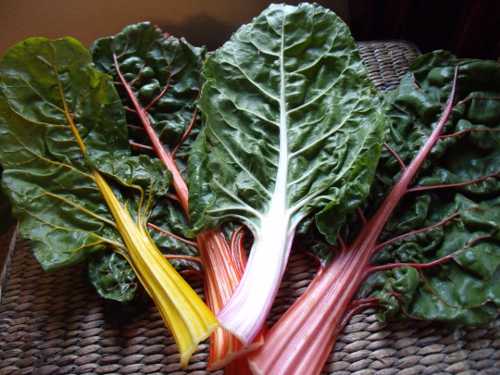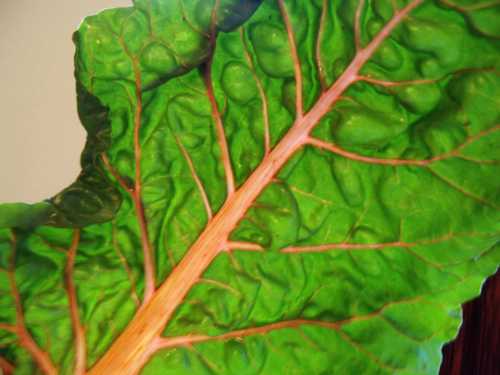
Chard’s deep green leaves are exquisitely laced with colorful veins, as though the fronds were crafted by a skilled artisan.
Each ruffled leaf – tasting similar to spinach, but with a tangy, earthy flavor – is a veritable fount of nutrition and the bright stems of some cultivars add a pop of color to the plate.
If not a colored variety, chard has silvery white celery-like stalks. Ruby and rhubarb chard have red stems and veins. Rainbow chard comes in an endless variety of colors, including yellow, pink, orange, red, purple and a number of striped versions. Another colorful chard goes by the name bright lights.
In general, colored chard is slightly less tender than those with white stems.
If you like to garden, colorful chard varieties make wonderful landscaping plants with the added bonus that they may be harvested for eating.
Chard goes by a number of aliases, including Swiss chard (a moniker designed to provide differentiation from its French spinach cousins in 19th century seed catalogs), silverbeet, perpetual spinach, spinach beet, crab beet, seakale beet and mangold.
Along with modern day garden beets, chard is one of the cultivated descendants of the sea beet, also known as wild spinach, a vegetable that grew naturally along European shorelines. The family resemblance between chard and beets is apparent in that they share similar foliage and coloration; one can see that they share a common ancestor.
Though, as its nickname implies, chard is grown in northern European countries such as Switzerland, it has its roots in the Mediterranean region. The French, Italians, Spaniards, Greeks and the Arabs of North Africa have made the most of this vegetable in their cuisines.
Chard’s history in cuisine is long; it goes back before the Roman and Greek civilizations to ancient Babylon.
The Greek philosopher Aristotle wrote about chard in the fourth century B.C. and both the Greeks and Romans prized the vegetable for its medicinal qualities.
As to nutrition, according to the “World’s Healthiest Foods” Web site (www.whfoods.org), chard is an excellent source of bone-building vitamin K, manganese, and magnesium; antioxidant vitamin A, vitamin C, and vitamin E; heart-healthy potassium and dietary fiber; and energy-producing iron.
It’s a very good source of bone-healthy copper and calcium; energy-producing vitamin B2 and vitamin B6; and muscle-building protein. In addition, chard is a good source of energy-producing phosphorus, vitamin B1, vitamin B5, biotin, and niacin; immune supportive zinc; and heart-healthy folate.
One can understand why the Greeks and Romans thought it to be powerful medicinally!
Chard is ready to harvest in late spring or early summer and will continue to produce stalks until November or the first hard frost. In areas with mild winters, chard produces its best growth and highest yields during those months.
Chard that is harvested while young and tender may be added raw to salad greens. As the leaves mature, they become tougher and develop a somewhat bitter taste, which is neutralized through cooking.
The stems are tougher than the leaves and require a longer cooking time, so they should be added first to the sauté pan or soup pot. For example, if adding to a soup or stew, allow 10 minutes to cook the stems and five to cook the leaves.
If using stems and leaves in separate applications, the stems may be prepared and used like asparagus and the leaves like spinach.
Chard is best stored in a loosely sealed plastic bag in the fridge where it will keep well for three to five days. Shake off any excess water from supermarket sprays prior to storing.
When shopping for chard, look for stems that are crisp, not limp, and for leaves with a glossy shine.

Chard makes a wonderful component for quiche, especially when paired with cheeses such as Fontina, Gruyere or Parmesan.
I especially enjoy it sautéed in a simple fashion with olive oil, onions and garlic until tender, cooking the diced stems first with the onions and adding the chopped leaves later with the garlic.
Chef Rick Bayless, owner of two fine dining Mexican restaurants in Chicago, pairs chard with poblano peppers to make a creative take on tacos with creamy braised chard.
British chef, author and television personality, Jamie Oliver, uses chard atop pizza, as well as pairing it with lamp chops and creamy cannelloni beans for a main dish.
Beans and lentils are a good match for chard, whether served side by side as Chef Oliver does, or added to a soup or stew.
The recipe I offer today is one by Deborah Madison, founding chef of Greens, a popular vegetarian restaurant in San Francisco. It’s from her book “Local Flavors,” which features recipes using seasonal farmers’ market produce.
I shared this recipe with students in a cooking class last year using local produce. It was a lot of fun to make, impressive to serve and we all thought it tasted good. I hope you enjoy it.
Chard and cilantro soup with noodle nests
The noodle nests
2 eggs, separated
3 ounces (1 ¾ cups) fine egg noodles, such as capellini, uncooked
1/3 cup grated Monterey Jack cheese
2 tablespoons chopped cilantro
Sea salt
Peanut oil for frying
Beat the egg whites until they hold firm peaks, then stir in the yolks, noodles, cheese, and cilantro. Season with a few pinches of salt, then really work the mixture with your hands or a wooden spoon so that it’s more or less homogenous. It will look impossibly dry and stiff.
Heat enough oil in a medium skillet over medium-high heat to float the noodles, at least 1/3 inch. When the oil’s hot, drop the batter into it, dividing the batter into 4 or 6 portions by eye.
Fry until golden, about 1 minute, then turn and fry the second side another minute. Set aside on paper towels. These can be made hours ahead of time.
The soup
1 tablespoons olive oil
2 bunches scallions, including an inch or 2 of the greens, finely chopped
1 celery rib, diced
1 cup finely chopped cilantro stems and leaves, packed
Leaves from 1 bunch chard, green or rainbow, about 6 cups, packed
Sea salt and freshly ground black pepper
6 cups vegetable stock, chicken stock or water
Cilantro sprigs for garnish
Warm the oil in a soup pot. Add the scallions and celery and cook over medium-high heat, stirring occasionally. After a few minutes, add the cilantro and ½ cup water so that the vegetables stew rather than fry. Add the chard leaves, sprinkle with 1 teaspoon salt, then cover and cook until the chard has wilted down. Add the stock or water.
Bring to a boil, lower the heat, and add the noodle nests to the pot. Simmer until the chard is tender, about 10 minutes. Taste for salt and season with pepper.
Ladle the soup into soup plates or bowls, include a noodle nest in each bowl, and serve garnished with a sprig of cilantro.
Esther Oertel, the “Veggie Girl,” is a culinary coach and educator and is passionate about local produce. Oertel teaches culinary classes at Chic Le Chef in Hidden Valley Lake, Calif., and The Kitchen Gallery in Lakeport, Calif., and gives private cooking lessons. She welcomes your questions and comments; e-mail her at This email address is being protected from spambots. You need JavaScript enabled to view it..
Follow Lake County News on Twitter at http://twitter.com/LakeCoNews , on Facebook at http://www.facebook.com/pages/Lake-County-News/143156775604?ref=mf and on YouTube at http://www.youtube.com/user/LakeCoNews .